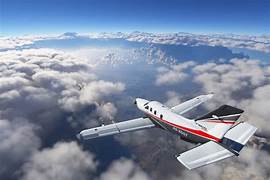FLIGHT SIMIULATOR
Exploring the World of Flight Simulator Games
Flight simulator games have captivated aviation enthusiasts and gamers alike for decades, providing an immersive experience of piloting aircraft from the comfort of one's home. These games range from highly realistic simulators used by professional pilots for training to more accessible versions designed for casual gamers. This article delves into the evolution, features, and requirements of flight simulator games, offering a comprehensive overview for both seasoned players and newcomers.
The Evolution of Flight Simulator Games
The history of flight simulators dates back to the early 1980s with the release of "Microsoft Flight Simulator," one of the first commercially available flight simulation games. Over the years, advancements in technology have allowed for increasingly sophisticated simulations. Modern flight simulators like "Microsoft Flight Simulator 2020" and "X-Plane 12" boast stunningly realistic graphics, complex flight dynamics, and detailed world environments.
Flight simulator games have evolved from simple 2D graphics to fully immersive 3D environments. The introduction of VR (Virtual Reality) technology has further enhanced the experience, allowing players to feel as though they are truly inside the cockpit. Additionally, the integration of real-time weather and traffic data has brought unprecedented realism to these games.
Features of Modern Flight Simulator Games
1. **Realistic Flight Dynamics**: Modern flight simulators replicate the physics of flight with great accuracy. They account for factors like air pressure, wind speed, and aircraft weight, providing a true-to-life flying experience.
2. **Detailed Aircraft Models**: Players can choose from a wide variety of aircraft, ranging from small single-engine planes to large commercial jets. Each aircraft is meticulously modeled with accurate interiors and functioning instruments.
3. **Global Scenery**: High-resolution satellite imagery and 3D rendering techniques are used to create detailed landscapes. Players can fly over iconic landmarks, bustling cities, and remote islands.
4. **Weather Systems**: Dynamic weather systems simulate real-world conditions. Players can experience flying through storms, heavy rain, snow, and even hurricanes.
5. **Multiplayer Mode**: Many flight simulators offer multiplayer options, allowing players to fly together, participate in virtual airshows, or complete cooperative missions.
6. **Customization and Add-ons**: A plethora of add-ons and mods are available, enabling players to customize their experience with additional aircraft, liveries, and scenery packs.
Requirements for Running Flight Simulator Games
Running modern flight simulators requires a robust setup to ensure a smooth and enjoyable experience. Here are the typical requirements:
1. **Hardware Requirements**:
- **Processor**: A high-performance CPU is crucial. For example, an Intel i5-8400 or AMD Ryzen 5 1500X (or better) is often recommended.
- **Graphics Card**: A powerful GPU is essential for rendering detailed graphics. Suggested options include NVIDIA GTX 970 or AMD Radeon RX 590 (or better).
- **Memory**: At least 8 GB of RAM is the minimum, but 16 GB or more is recommended for optimal performance.
- **Storage**: SSDs are preferred due to faster load times. A game like "Microsoft Flight Simulator 2020" requires around 150 GB of free storage space.
- **Display**: A high-resolution monitor enhances the visual experience, and a multi-monitor setup can provide a more immersive cockpit view.
2. **Software Requirements**:
- **Operating System**: Most modern flight simulators are compatible with Windows 10. Some, like "X-Plane," also support macOS and Linux.
- **DirectX**: DirectX 11 or 12 is typically required for handling the game's graphics.
3. **Optional Equipment**:
- **Flight Controls**: Yokes, joysticks, and rudder pedals can significantly enhance the realism of the simulation.
- **VR Headset**: For an immersive experience, VR headsets like the Oculus Rift or HTC Vive are compatible with many flight simulators.
- **Networking**: A stable internet connection is necessary for downloading updates and accessing real-time data.
Conclusion
Flight simulator games offer a unique blend of education, entertainment, and challenge, appealing to both aviation professionals and hobbyists. With continuous technological advancements, these simulators are becoming increasingly realistic, making it possible for anyone to experience the thrill of flying. Whether you are a seasoned pilot looking to hone your skills or a curious gamer eager to explore the skies, flight simulators provide an unparalleled virtual adventure.









0 $type={blogger}:
Post a Comment